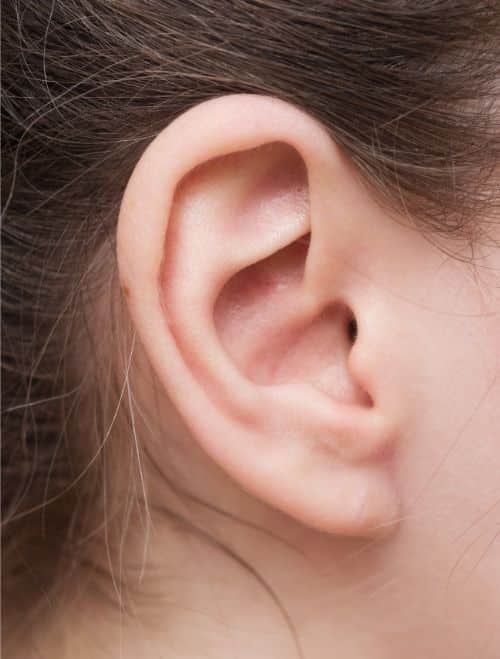Ear surgery (otoplasty) can improve self confidence and self esteem by bringing ears that stick out closer toward the head or rebuilding misshapen ears. However, concern about otoplasty scars often leads patients to reconsider this procedure.
In fact, there’s good news: Scars after otoplasty tend to be extremely well-hidden and hard to see after otoplasty recovery.
Well-qualified plastic surgeons like Dr. Ashley Steinberg know how to situate ear surgery incisions behind the ears and out of sight. Moreover, your scars will fade and flatten out as the years go by — leaving you with an improved ear appearance and no noticeable scarring from the procedure.
What Do Otoplasty Scars Look Like?

Each scar generally runs down the back of the ear, near the crease where the ear meets the head. Scar length depends on the procedure, but can be around two inches.
Rarely, raised or keloid scars may occur. Light massage can often help, or you may inquire about scar revision surgery. This usually involves laser treatments or use of cortisone injections. If your ears stick out even after surgery, you may also require revision otoplasty.
Does Otoplasty Leave Scars in Front of the Ear?
This depends on the situation. With most ear pinning procedures, incisions are located behind the ear. But, more rarely, surgery on the ears may need to be performed on the front of the ear. This may occur if the patient was in an accident or has a birth defect, for example, and the front of one or both ears was damaged.
Rest assured that if this is the case, a qualified plastic surgeon who has adequate experience performing otoplasty will be sure to locate their incisions in the folds of the ear so that they heal out of sight. If you’d like to see examples of such scars, look up otoplasty scars pictures for patients requiring front-of-ear surgery.
Are Otoplasty Scars Visible?
The majority of scars after otoplasty surgery will not be noticeable. This is for several reasons.
Location
First, otoplasty incisions are located behind the ears, which is a naturally hidden area. Most people don’t look here, so they won’t see your scars in this location. Furthermore, a lot of people can hide these scars with their hair.
Surgeon Skill
Next, your plastic surgeon is going to do their utmost to make your incisions as small and as clean as possible. They will pay close attention to the closing of the incisions so that they are carefully closed and heal well. Hypertrophic scarring is rare after otoplasty.
Scar Treatments
We also have techniques we can use to reduce the appearance of your otoplasty scars. First, massage is often used in the few weeks following surgery. Also, patients sometimes choose to use a scar cream or scar gel made of silicone on their incision sites. Regular use of these products can often do wonders for reducing the appearance of scars.
Healing Time
Lastly, scars naturally fade with time. Otoplasty techniques are frequently performed, so we know that most of the associated incisions heal very well and generally fade. The “final appearance” of your scars will be around the one-year mark. After this, you should see your scars reducing in visibility.
Tips for Otoplasty Recovery
As you heal from otoplasty surgery, be sure to follow these tips:
1. Get plenty of rest.
After any type of plastic surgery, including ear surgery, it is imperative that patients get adequate sleep and daily rest. This is when healing happens.
2. Take pain medication to improve discomfort.
Otoplasty patients may experience pain and discomfort in the first few weeks following surgery. Pain medications can be prescribed to help with this.
3. Refrain from physical activity.
It’s also important to limit physical activity during your otoplasty recovery period. You don’t want excessive blood flow in your treatment area as this may compromise your results or cause problems for you as you heal.
4. Communicate openly with your surgeon.
In most cases, patients are extremely happy with their results and don’t have issues with their ear surgery incisions. However, if you do notice keloids forming or any other issues with your scars, be sure that you don’t wait to contact your doctor. The sooner you can catch any potential problems, the better.
FAQ: Otoplasty
How much is otoplasty?
Otoplasty cost varies from patient to patient and depending on whether additional procedures are performed at the same time, such as Botox & Dysport, or fillers, etc. Other cost factors include hospital or surgical facility fees, general anesthesia or local anesthesia, surgical techniques, etc.
Please schedule a consultation appointment with Dr. Steinberg to get a quote for surgery.
Who’s a good candidate for ear surgery?
A good candidate for otoplasty is someone who is unhappy with the appearance of their ears. If you have prominent ears that stick out away from your head, malformed or misshapen ears, or any other cosmetic ear issue, you may be a good candidate for cosmetic ear surgery.
Is otoplasty safe?
While there are otoplasty risks — just as there are with any surgical procedure — it is rare to encounter complications during or after your surgery. Otoplasty patients should inquire about the most common risks and potential complications associated with this surgical treatment at their otoplasty consultation appointment.
Schedule a Plastic Surgery Consultation Today

References
https://www.mayoclinic.org/tests-procedures/otoplasty/about/pac-20394822













